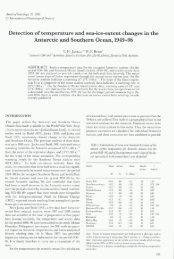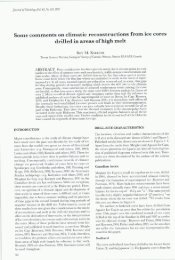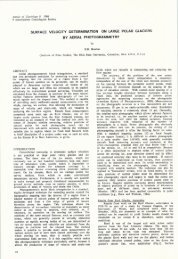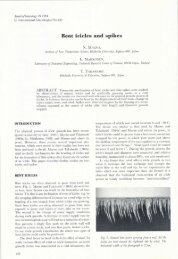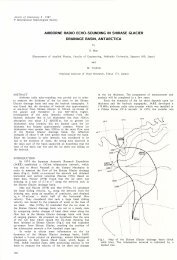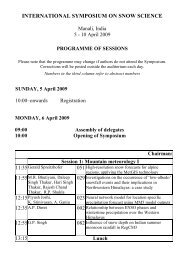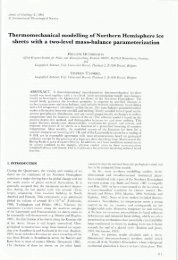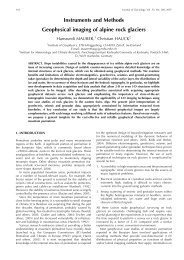143-156 - International Glaciological Society
143-156 - International Glaciological Society
143-156 - International Glaciological Society
Create successful ePaper yourself
Turn your PDF publications into a flip-book with our unique Google optimized e-Paper software.
Journal of Glaciology, Vo!. 23, No. 89, 1979<br />
SIMULATED GLACIER SLIDING OVER AN OBSTACLE<br />
By R. BREPSON<br />
(Alsthom-Atlantique, Grenoble<br />
and Laboratoire de Glaciologie du CNRS, 2 rue Tres-Cloitres, 3803 I Grenoble Cedex, France)<br />
ABSTRACT. The sliding of temperate ice over two obstacles with sine-wave profiles (wavelength, 0.53 m;<br />
maximum slope, 0.22) and low thermal conductivity has been reproduced at full scale within a steel chamber.<br />
As expected, large cavities form between the ice and the obstacles so that the drag is limited. However,<br />
the delayed elasticity of bubbly ice modifies the expected behaviour. At the base of the ice a fine-grained,<br />
bubble-free blue ice layer develops. The shear strain concentrates on the up-stream side of bumps and in<br />
the blue ice layer. Tap-water ions enhance tertiary creep-rates.<br />
RESUME. Simulation du glissement d'un glacier sur une bosse. On a reproduit le glissement d'un glacier tempere<br />
sur deux bosses (Iongueur d'onde, 0,53 m; pente maximale, 0,22) en vraie grandeur dans une chambre<br />
d'acier. I1 se forme vraiment de grandes cavites, qui empechent le frottement de s'eJever, mais I'elasticite<br />
differee de la glace bulbeuse modi fie le comportement auque1 on s'attendait. A la base se developpe une<br />
couche de glace bleue, sans bulles et it grains fins. Le cisaillement se con centre sur la face amont des bosses<br />
et dans la couche de glace bleue. Les ions de l' au de ville favorisent le fluage tertiaire.<br />
ZUSAMMENFASSUNG. Simulation des Gletschergleitens uber einen Buckel. Das Gleiten eines temperierten<br />
Gletschers iiber zwei Bucke1 (Wellenlange, 0,53 m; maximales Gefalle, 0,22) wurde im Originalmassstab<br />
innerhalb einer Stahlkammer nachgebildet. Es bilden si ch tatsachlich grosse Hohlraume, die ein Anwachsen<br />
des Zugwiderstandes verhindern, doch verandert die verzogerte Elastizitat blasenreichen Eises das erwartete<br />
Verhalten. An der Unterseite entwickelt sich eine Schicht feinkornigen, blasenfreien Blaueises. Die Scherspannung<br />
konzentriert sich auf die stromaufwarts gelegene Seite der Buckel in der B1aueisschicht. Die Ionen<br />
des Leitungswasser begunstigen tertiares Kriechen.<br />
INTRODUCTION<br />
The idea of reproducing in the laboratory the conditions which exist at the ice-bedrock<br />
interface originated in February 1962 during a seminar given by Professor L. Lliboutry on<br />
the theory of glacier sliding. He showed that the laws describing permanent and transient<br />
creep in ice were ill-defined, calculations relating to the creep were in their infancy, and<br />
important processes had not been considered. The complexity of the creep law made it<br />
difficult to change the time scale and, since at least two other parameters were important, the<br />
machine had to be designed on a large scale. The technological problems looked formidable,<br />
but this was an inducement to carry out the work. A viscometer named "Penelope", was<br />
constructed in 1964 and modified several times between 1966 and 1977.<br />
In spite of its imperfections, the viscometer has enabled deep insight to be made into the<br />
processes occurring at the ice-rock interface. In the meantime, sliding theory has been<br />
considerably improved (Lliboutry, 1968; Nye, 1969; Kamb, 1970). Thus, the experiments<br />
carried out using Penelope are now quantitative. Strain-rates around a bump can be<br />
measured in order to check the assumptions of sliding theories.<br />
DESCRIPTION OF THE VISCOMETER<br />
Mechanical details<br />
Since a linear machine would have to be prohibitively long to be able to reach a steady<br />
state, a circular design similar to that of a large Couette viscometer was preferred (Fig. I).<br />
The outer, moving part consists of two steel hemispheres (1-2), with a steel annulus between<br />
them. On the inside of this annulus, another annulus made of plastic-impregnated wood (3)<br />
is fastened. This has 20 cogs which pull a circle of ice around, simulating the drag of basal<br />
ice by a glacier. The arrangement is secured by threaded bolts and nuts (9). This almost<br />
spherical enclosure of about 0.60 m diameter can withstand a pressure of 100 bar.<br />
<strong>143</strong>
144 JOURNAL OF GLACIOLOGY<br />
Fig. 1. Diagram of the viscometer.<br />
A cog wheel moved by a worm gear (6) is driven by an electrical motor through two gearboxes<br />
and a speed reducer. A drum made of moulded plastic (Hi) with diametricallyopposite<br />
raised obstacles simulates the bedrock, it is attached to a stationary steel hub (10).<br />
The hub transmits the torque to a calibrated steel rod (8); the opposing torques on this rod<br />
and on the worm gear balance through the U-shaped supports (7). At its upper end the hub<br />
is fastened to a flared hollow column (5) which centres the upper surface.<br />
Between the toothed annulus and the drum an ice ring is formed. Its dimensions are<br />
given in Figure 2. When the machine operates the flow is two-dimensional and the sliding<br />
on the cogs (principally by melting-refreezing) is negligible. The velocity on the bumps is<br />
100 m/year if the mobile enclosure makes one revolution in 98.5 h. Experiments were made<br />
with velocities in the range 60-1 000 m/year.<br />
Pressure control<br />
The pressurized enclosure is divided into two chambers by a base (4). The upper chamber<br />
is filled with water, the lower one with oil. The same pressure, provided by a nitrogen<br />
cylinder, is applied to the water through (17) and to the oil through (19). This arrangement<br />
was designed because the viscometer was not originally in a cold room. At that time the oil<br />
chamber was cooled and the machine was insulated with a polyurethane jacket. The main<br />
difficulties were that it was impossible to remove the ice from the viscometer at the end of<br />
an experiment, because of the delayed elastic response of bubbly ice. It was also difficult to<br />
keep both sides of the ice watertight, in order to allow the water pressure in the cavities to be<br />
independent of the confining pressure. Further, it was difficult to maintain the ice at the<br />
melting-point for a long time with only negligible melting. This problem was solved when a<br />
new building for the Laboratoire de Glaciologie was constructed in 1973. Today, with the
SIMULATED GLACIER SLIDING<br />
312<br />
A A<br />
,<br />
\\<br />
\\<br />
\ T<br />
/'"<br />
/ A<br />
Fig. 2. The drum with its two obstfle/es fllld the ice fllI/IIIIII.
JO URNAL OF GLACIOLOGY<br />
keep the upper cheek reliably watertight, a slight refreezing along the ring (16) has been<br />
used since 1977. The refrigeration comes from another cooling system which moves with the<br />
steel enclosure.<br />
Temperature control<br />
Temperature control was difficult until the viscometer was set up in a room at o°C. Three<br />
thermistors were originally provided (Fig. 3): one inside the hub (SI), another within the ice<br />
(S2), and a third on the driving cogs (s3). The first thermistor, since it had a much faster<br />
response to changes in the cooling-rate, was used for temperature regulation. In the present<br />
version of the viscometer, the thermistors on the obstacles (Fig. 4) achieve an adequate temperature<br />
control. The temperature variations on the up-stream side of the bumps are<br />
recorded in the most recent tests, the temperature response is almost instantaneous.<br />
- A B<br />
Fig. 3. February 1973 experimetlt.<br />
A. The appearance of the marks bifore diformation.<br />
B. Subsequent appearance of the marks after 5.05 revolutions.<br />
There is significant diformation in the "basal" layer.<br />
CAVITY FORMATION AND TORQUE MEASUREMENTS<br />
Formation cif cavities<br />
The upper hemisphere is now fitted with observation ports for the observation of the ice,<br />
but iu' modifications were originally observed by releasing the confining pressure and opening<br />
the chamber.<br />
The ice annulus is made by soaking crushed ice with melt water fr om similar ice (or tap<br />
water in the case of commercial ice), and cooling the mixture. Air bubbles cannot be completely<br />
eliminated, and the normal density of this artificial, isotropic ice is about 0.86 Mg/m3.<br />
There was originally a large gap between the upper surface of the drum and the driving<br />
cogs in order to allow ice to flow outwards during the formation of the cavities. This process<br />
has not, in fact, been observed, probably because bubbly ice is compressible. Under the<br />
pressure of several tens of bars, generated at the up-stream surface of the obstacles, the bubbly<br />
ice contracts by about 4 % by collapse of the air bubbles. Bubbly ice behaves as a viscoelastic<br />
material, with a large delayed elasticity. Thus, on the down-stream side of the bumps there is<br />
no immediate elastic rebound, and cavities are fo rmed from the beginning of the experiment.<br />
They grow a good deal during the first half revolution, and very slowly after this.
SIMULATED GLACIER SLIDING<br />
/'<br />
Upstream<br />
PreS5urf' gouge<br />
Oowns!rf'om<br />
"', ,<br />
'-..<br />
COV;f<br />
Fig. 4. Diagram showillg the sensors attached to each obstacle.<br />
Consequences of this are: (I) a large torque is measured even when both the confining<br />
pressure and the pressure in the cavities are at atmospheric pressure; (2) at the beginning of<br />
the experiment, when the cavities are not yet formed, the torque does not rise to very high<br />
values, even with high sliding velocities. The torque will be expressed as a mean drag over the<br />
"bedrock" Tb. Tb is always less than 3 bar, even for a sliding velocity U of 145 m/year.<br />
A new drum with larger cheeks was constructed after the discovery of this unexpected<br />
behaviour. This increase in size does not allow any ice outflow, but does permit any water at<br />
the working pressure to penetrate between the ice annulus and the driving cogs. Of course,<br />
there is a danger that, if the bubbly ice is not compressible enough to allow the formation of<br />
large cavities, the mean pressure within the ice ring will rise well above the confining pressure.<br />
This is prevented by allowing the ice annulus to melt very slowly (rather than freeze very<br />
slowly by cooling too strongly). This is a makeshift arrangement which makes very accurate<br />
and continuous control necessary. In Penelope's successor (a new machine called Telemachus)<br />
a much better solution has been adopted; the confining pressure is obtained by squeezing the<br />
ice with a ram coupled to a hydraulic jack.<br />
Variation of the drag with time<br />
Surprisingly, the variations in the torque when the machine starts are almost independent<br />
of the size of the cavities. Figure 5 is an example of this behaviour, it refers to an experiment<br />
of May 1970, with a sliding velocity U = I I I m/year, in the autonomous regime, using ice<br />
frozen from tap water. There was no confining pressure, but the mean pressure in the ice was<br />
certainly higher than atmospheric.<br />
At time t = 0, the machine was started, at this stage cavities are not present. The rapid<br />
increase in the drag should be governed by the elasticity of bubbly ice (the machine is stiff<br />
enough to make its elastic deformation almost negligible). At t = 16,5 h (0.188 revolution)<br />
and 5 1.5 h (0.586 revolution) the machine was stopped; the drag was observed to faU exponentially,<br />
this shows the delayed elasticity. When the machine was set in motion again there was:<br />
147
JOURNAL OF GLACIOLOGY<br />
:,?::=£<br />
o
Estimation of the real pressure within the ice<br />
SIMULATED GLACIER SLIDING 149<br />
As already explained, we can have no confidence that the mean pressure in ice Pi (which<br />
simulates the glacier weight) equals the confining water pressure Pc. Nevertheless, this<br />
important parameter has been estimated by the following procedure:<br />
If the pressure in the cavities is suddenly changed by - 6.p (the length of the cavities<br />
having no time to change), the change of the drag 6.Tb is the same as if the pressure of ice<br />
against the up-stream side of the obstacles had been increased by 6.p. Following Lliboutry's<br />
notation (Lliboutry, 1975) let N = Pi-P be Terzaghi's effective pressure and s the ratio of<br />
the area in contact to the total area of the "bedrock". The mean pressure of ice against the<br />
obstacle where there is contact is N/s. Since it has been shown in many experiments that<br />
6.Tb is exactly proportional to 6.p, we assume that the same ratio exists between Tb and N/s.<br />
It is then sufficient to measure Tb, 6.Tb/6.P, and s to obtain N.<br />
For example, during the experiment of February 1973, with V = 208 m/year,<br />
6.Tb/6.P = 0.066±0.00I. Since Tb = 3.7 bar,<br />
N 3.7<br />
-:;:- = = 56 bar.<br />
0.066<br />
Now the length of ice in contact with each obstacle was 9.0±0.2 cm, and since ..\=53.6 cm,<br />
s = 9.0/53.6 = o. I 7, and thus N = 9.5 bar. During this experiment P = 0 and Pc = 5 bar,<br />
relative to atmospheric pressure. If we had assumed Pi = pc, we should have obtained the<br />
incorrect value for N of 5 bar. Nevertheless, this estimation is still not entirely accurate<br />
because s changes progressively when P is altered. For this reason, and because it has not been<br />
possible until recently to maintain pressure values steady for several weeks, we cannot give<br />
any law for Tb(N) at the moment.<br />
I CE PETROLOGY<br />
The thermal conductivity of "Afcodur-PVC" (1.6 kJ/m/deg/h) is of the same order of<br />
magnitude as that of rock (e.g. 3.6 kJ /m/deg/h for limestone). Some regelation ice is found<br />
in the cavities, near the point where the ice annulus separates from the "bedrock". Nevertheless,<br />
as will be shown in the next section, most of the sliding comes from plastic deformation.<br />
This is consistent with the theory without cavitation, which indicates that<br />
Up/Vr = ("\/)..>/-)2,<br />
where Up is the plastic sliding contribution, UI is the contribution to sliding made by the<br />
melting-refreezing process, and ..\>/- is the transition wavelength. The latter is estimated by<br />
Lliboutry (1975), in the metre-bar-year unit system, as<br />
..\>/- = 0.63(UTh)-".<br />
In all our experiments U> 60 m/year and Th> I bar, whence ..\>/- < 0.16 m. Since<br />
..\ = 0.536 m, we have Up/Ur > I I.<br />
After 1.5 revolutions the ice nearest to the hub becomcs slightly clearer. After 8.5 revolutions<br />
a layer of blue, perfectly bubble-free ice, 3 cm thick, has been fo rmed. We shall see that<br />
this "basal" ice close to the obstacles and the cavities has been deformed the most. It is not<br />
regelation ice because small geometric figures marked in the ice during experiments become<br />
deformed but do not disappear (Fig. 3). The ice crystals are very minute (about I mm'<br />
in cross-sectional area, as measured on thin sections), and the air bubbles have been expelled<br />
into the cavities, where the pressure is less. Merrill (1960) has already observed a slow<br />
migration of bubbles near a sampling hole dug in the wall of a tunnel in cold ice. With<br />
temperate ice, large strain-rates, and a strong recrystallization the expulsion of air bubbles is<br />
much faster.
JOURNAL OF GLACIOLOGY<br />
A strong ice fabric develops during the experiments which is similar to one observed in<br />
glaciers (Rigsby, 1960; Vallon and others, 1976). It is very well developed in the blue ice. A<br />
stereogram is given (Fig. 7). The c-axes cluster in a girdle with four maxima, two of the<br />
maxima (with 25% of the crystals in each one) point laterally at about 45° from the plane of<br />
symmetry, another (15% of the population) points backwards (when seen from above, i.e.<br />
from the driving cogs towards the hub), the fourth maximum points forward. This ice fabric,<br />
already observed in glaciers, was reproduced for the first time in our laboratory, in 1968 using<br />
Penelope. Since then Duval (1976, in press) has shown that this ice fabric always forms by<br />
syntectonic (parakinematic) recrystallization when the state of strain is not simple shear.<br />
OBSERVED STRAINS<br />
First rough technique<br />
x xX<br />
x x<br />
Fig. 7. Ice fabric formed in blue ice.<br />
The first method used to observe strains was to put a square frame (47 X 47 mm2) within<br />
the ice in a plane perpendicular to the axis of the machine with two sides parallel to the<br />
"bedrock" (the circumference of the drum). The sides of the frame were 5 mm thick, and<br />
saw-cuts were made at the four corners to allow it to deform to a rhombus. Successive<br />
positions of the frames are shown in Figure 6. The deviations of these frame angles from 1T/2<br />
are given in Table 1. In both experiments the ice was made with tap water. Deformation<br />
occurred whilst the frame was moving along the up-stream side of the obstacle. There was no<br />
significant deformation after this until the second obstacle was reached, only rotation occurred,<br />
with the "upper side" moving faster. The deformation over the second obstacle was less,<br />
probably because the rhombus no longer had two sides parallel to the "bedrock".<br />
TABLE 1. DEVIATIONS OF THE FRAME ANGLES FROM 1'(/2 rad<br />
Experiment A (Fig. 6A)<br />
Experiment B (Fig. 6B)<br />
Sliding<br />
velocity<br />
m/year<br />
425<br />
425<br />
425<br />
III<br />
II I<br />
Time<br />
h<br />
5<br />
27<br />
42<br />
9<br />
26,3<br />
* Shown as a clear square in Figure 6B.<br />
t Shown as a dotted square in Figure 6B.<br />
rrame angles<br />
rad<br />
0.26±0.04<br />
0.29±0.04<br />
0·47±0.03<br />
0.007 ±0.001 * 0.065± 0.01 5 t<br />
o.132±0.003* O.053±O.013t
SIM ULATED GLACIER SLIDING 151<br />
In Experiment B, when passing over the first three-quarters of a bump, the clear frame<br />
(Fig. 6) was deformed by 0.125 rad. When passing over the second half of an obstacle, the<br />
dotted frame was deformed by 0.065 rad. Thus, on this occasion, the deformation went on<br />
in the same direction over the down-stream side of the obstacle. Over the whole bump it<br />
was about 0.16 rad instead ofo.29 rad as in Experiment A. Rotation was negligible in B.<br />
Explanation of the results<br />
The only simple analytical solution with which these results may be compared is that for<br />
the case of no cavitation, infinitesimal slopes, and Newtonian viscous ice. These assumptions<br />
are so far from the truth that we may assume without inconvenience that the ice slides over a<br />
sine curve z = a cos wx from x = - CA) to + 00 instead of considering circular sliding where<br />
r = ro+a cos we. It can be shown that the variations in pressure over the driving cogs<br />
(wz = 1.4) are 3.019 times larger than for a semi-infinite solid (Appendix). On the bumps<br />
(z = 0) the pressure variations are 2.443 times larger, the same applies for the drag which is<br />
Tb = 2-4431)Ua2w3.<br />
The frames were put midway between the cogs and the bumps (wz = 0.7). If cavitation<br />
does not occur in the Newtonian-viscous case, the total rotations on the up-stream side of a<br />
bump should be n = -0.008 rad and the shear deformation €xz should equal -0.072.<br />
This is not the case in our experiments, because the general shear caused by the drag has been<br />
ignored. This shear for a full wavelength is<br />
Yb = 2·443Ua2wlT = 2·443a2w3,\<br />
= 2.443 X 2'TTa2w2 = 0.443 6.<br />
The experiments show that, in the case of cavitation, most of this shear concentrates over<br />
the area where ice and bedrock are in contact, the more so as the sliding velocity increases.<br />
Much more precise numerical computations are in progress, using the finite-difference<br />
method and the finite-element method. They will be published elsewhere.<br />
A more accurate technique for the measurement of strain<br />
In order to measure the normal strains as well as the angular deformations, small plastic<br />
markers were put within the ice, along different radii, numbered 0 to 19. One layer] was<br />
5 cm from the lower side, another layer R at 4 cm from the upper side. Their motion was<br />
identical, indicating that the flow was effectively two-dimensional. Only a fe w marker<br />
positions are indicated on Figure 8. In this figure, A indicates the starting point and 0 the<br />
10<br />
-<br />
12 I 13<br />
8 17<br />
7<br />
Fig. 8. Motion of marks during the January 1973 experiment.<br />
15<br />
0<br />
16<br />
19<br />
18
JOURNAL OF GLACIOLOGY<br />
end point. The position of the marks was accurately determined by measuring their distance<br />
to several driving cogs.<br />
Experiment of January 1973 (tap-water ice)<br />
Only 1.323 revolutions were carried out at a sliding velocity of 145 m/year. The experiment<br />
was so short that blue ice did not form. The results are plotted in Figure g. The markers<br />
which were on the same radius remained in a straight line. For the marks RO and JO, which<br />
passed over two obstacles, the total angular deviation was 0.2 11 ±0.012 rad. For the marks<br />
J8, RI2, and JI2, which passed over three obstacles, the deviation was 0.476±0.023 rad.<br />
It may be that during the first traverses over the obstacles the cavities were not yet well<br />
developed and the strain was less concentrated. The ice crystals, although still not very<br />
large, were of a significant size after 80 h (Fig. 10).<br />
x<br />
/'<br />
1<br />
/<br />
r<br />
i/jI<br />
I<br />
, ,Q<br />
I1 .<br />
I I- I<br />
I / /<br />
J8<br />
j RI2<br />
JO /<br />
j}12<br />
Cogs<br />
Fig. 9. The ObSer1'fd shFar after 1.323 revolutiolls at a speed oJ 145 m/year ill the .Jalluary 1973 experiment,<br />
Fig. 10. IceJabricJrolll the .January 1973 experiment; tap-water ice deJonuedJor 80 h.
Experiment of February 1973 (tap-water ice)<br />
SIMULATED GLACIER SLIDING 153<br />
The velocity was <strong>143</strong> m/year for the first 1.3 revolutions and subsequently 208 m/year.<br />
The markers were placed as indicated on Figure 3A. After 5.05 revolutions lasting 270 h<br />
the situation was as shown in Figures 3B and I I. A bottom layer of blue ice, 2 cm thick,<br />
formed where the shear strain was strongest (Yxz :::: : 0.83). Above it, in the bubbly layer, the<br />
square of 47 X 47 mm2 became a rectangle of 53 X 40 mm2• Final values for the strain are<br />
and<br />
Yxz = 0.13 ±0.03,<br />
Exx = 0.I2,<br />
EZZ = -0.16.<br />
The density of the bubbly ice has thus increased by 4 % (0.860 to 0.895 Mg/m3). Figure<br />
13 shows crystals with very fine grain size in the boundary layer of the blue ice.<br />
r R8 RI2 RI8<br />
,/ / tc'/<br />
/0 / T<br />
R2 l /x /<br />
I/o /<br />
dl-<br />
'1<br />
/<br />
' . /<br />
II<br />
, xl<br />
I I<br />
If'<br />
1<br />
I<br />
o<br />
,<br />
,<br />
x--- -+- -- -- -- -- -- -<br />
Cogs<br />
Fig. 11. Observed shear in the FebruaT}' 1973 experiment; tap-water ice diformed by 5.05 revolutions.<br />
Fig. 12. Ice fabric from the February 1973 experiment; tap-water ice diformedfor 200 h.
JOURNAL OF GLACIOLOGY<br />
I<br />
fJO<br />
f<br />
+f<br />
If<br />
9<br />
f<br />
x-- ---<br />
-- -- -- -- --<br />
Cogs<br />
Fig. 13. Observed shear in the April 1973 experiment; distilled-water ice deformed by 5.30 revolutions.<br />
Fig. 14. lee fabric jrom the April 1973 experimmt; distilled-water ice deformedfor 365 h.<br />
Experiment of April [973<br />
The velocity in this experiment was <strong>143</strong> m/year for a total duration of 365 h (5.30 revolutions).<br />
On this occasion the ice was made from distilled water instead of the tap water used<br />
in previous experiments. The same layer of blue ice about 3 cm thick was formed, but within<br />
it the shear strain was substantially less, as shown in Figure 14. On the other hand, "Tb was<br />
1.66 times' higher. Figure 14 shows the much larger blue-ice crystals which are obtained with<br />
distilled water. This indicates that the ions present in tap water enhance ice recrystallization<br />
and creep.<br />
CONCLUSIONS<br />
Although they have certain errors, the experiments carried out in 1970 and 1973 with<br />
the viscometer indicate that important facts are ignored in the present theories. The delayed<br />
elasticity of bubbly ice, which is much more important than the pseudo-elasticity of Duval<br />
([1977]) and which is of the Kelvin not of the Maxwell type, cannot be ignored; it increases<br />
the drag. The progressive elimination of air bubbles from the bottom ice of glaciers would
SIMULATED GLACIER SLIDING<br />
appear to be an important process. A better simulation of sliding processes would occur if<br />
bubble-free ice were used. Kamb's (1970) statement that the layer of blue ice found at the<br />
bottom of glaciers is caused by regelation may be questioned; in the ice tested here it is not<br />
the case. This is consistent with the findings of Souchez and others (1978) who have shown<br />
that the ionic composition of base glacier ice cannot arise as a result of a classical melting-<br />
. refreezing process.<br />
Creep-rates in ice are considerably altered by the presence of ions. This makes it very<br />
difficult to reproduce the exact mode of basal deformation over an obstacle. At best we may<br />
determine the friction law over a sine profile for different known ionic contents.<br />
A new viscometer, a development of Pen elope, is now ready to work in Grenoble. Nevertheless,<br />
Penelope will still be useful because the flow in it is two-dimensional and very high<br />
confining pressures can be attained; this will not be possible with the new viscometer.<br />
ACKNOWLEDGEMENTS<br />
My thanks are due to Alsthom-Atlantique who provided time for the present work, to<br />
Professor Lliboutry for his help in interpreting the results and in writing this paper, to Miss<br />
M. 1. Clement for her assistance with the experimental work, to Mr A. Chaillou and Mr L.<br />
Philippe for their electronic and mechanical expertise, and to CNRS for the provision of<br />
funds.<br />
The profile of the "bedrock" is given by<br />
the boundary conditions are<br />
for z = h,<br />
(I) forward velocity u = V, a constant;<br />
(2) transverse velocity w = 0;<br />
for z :::: :: 0,<br />
(3) shear strain-rate<br />
APPENDIX<br />
": = a cos wx,<br />
ou ow<br />
)lxz = az + ox = 0 ;<br />
(4) to second order, q(x, z) denotes the strain function, q = 0 gives z = a cos wx.<br />
A general solution of the biharmonic equation y4q = 0 is<br />
q = f(z) cos wx+g (z) sin wx+C,z+C,z'+CJz"<br />
f(z) and g(z) being of the form (A+Bwz) exp (wz)+ (C+Dwz) exp (-wz). The boundary conditions are then<br />
(I) f'(h) = 0, g' (h) = 0,<br />
C,+2C,h+3CJh' = V,<br />
(2) f(h) = 0, g(h) = 0,<br />
(3) f" (o)+w'f (o) = 0, g" (o)+w'g (o) = 0,<br />
C, = 0,<br />
(4) f(o) = -Va, g(o) = o.<br />
The four relations<br />
g(h) = g' (h) = g(o) = g" (o) = 0<br />
imply that g(z) = o. In order not to have a constant term for<br />
C, = 0 is needed.<br />
Hence,<br />
ca", OTxz<br />
Tx -az-'<br />
C=-A-Va, D=B-Va, }<br />
A (exp (2wh)-I)+Bwh (exp (2wh)+I) =<br />
.<br />
Va (l+wh),<br />
2A exp (2wh)+B[ (1+2Wh) exp (2wh)+I] = Va.<br />
(A-I)
JO URNAL OF GLACIOLOGY<br />
In our case, h = 0.12 m and wh = 1.4. Finally,<br />
u = [U+ Uaw2z exp (-wz) cos wx] + Uaw(0.727 cosh wz-o.716wz sinh wz) cos wX }<br />
W = [- Uaw( 1+ wz) exp ( - wz) sin wx] + Uaw( 1.443 sinh wz-o. 716wz cosh wz) sin wx,<br />
the terms in square brackets are the solution for h = 00. With a uniform velocity at a finite distance the modification<br />
is not negligible, in particular, against the "bedrock" the forward velocity u increases over the bump. The<br />
normal stress at is calculated as<br />
aUt ( a'u a2U)<br />
Tz = -1/ 3 aX2 + aZ2 .<br />
(A-3)<br />
It yields<br />
at = [-Pi + 2TJUaw2( 1+ wz) exp (- wz) sin wx] +<br />
+ 2TJUaw'(1.443 cosh wz-o.716wz sinh wz) sin wz,<br />
o 0<br />
au dx<br />
·<br />
[ 8<br />
] ·<br />
= az U = -0.471 aw Sin wz ->/, = -0.080,<br />
-T/2 -AI.<br />
J au d<br />
t<br />
az I<br />
o<br />
aw<br />
J<br />
[WJ"<br />
ax dt = 7J -,,,<br />
- Tt2<br />
= [ -0.378 65aw sin wx]w = -0.054.<br />
REFERENCES<br />
Brepson, R. 1966. Premiers resullats obtenus avec le viscosimetre a glace de Grenoble. Comptes Rmdus Hebdomadaires<br />
des Seances de l'Academie des Scietlces (Paris), Ser. B, Tom. 263, No. 15, p. 876-79.<br />
Duval, P. 1976. Fluage et recristallisation des glaces polycristallines. Publication du Laboratoire de Glaciologie du<br />
CNRS, GrClloble, No. 215.<br />
Duval, P. [1977.] Lois du fluage transitoire ou permanent de la glace polycristalline pour divers etats de contrainte.<br />
All/wles de Geophysique, Tom. 32, No. 4, 1976, p. 335-50.<br />
Duval, P. In press. Creep and fabrics of temperate polycrystalline ice under shear and compression. Journal oJ<br />
Glaciology.<br />
Kamb, "v. B. 1970. Sliding motion of glaciers: theory and observation. Reviews of Geophysics and Space Physics,<br />
Vol. 8, No. 4, p. 673-728.<br />
Lliboutry, L. A. 1968. General theory of subglacial cavitation and sliding of temperate glaciers. Journal of<br />
Glaciology, Vol. 7, No. 49, p. 21-58.<br />
Lliboutry, L. A. 1975. Loi de glissemcnt d'un glacier sans cavitation. AII/wles de Geophysique, Tom. 31, No. 2,<br />
p. 207-25.<br />
Merrill, W. M. 1960. Structures in glacier ice, north ice cap, northwest Greenland. Report of the <strong>International</strong><br />
Geological Congress, XXI Session, Norden, 1960, Pt. 2 I, p. 68-80.<br />
Michel, B. 1978. A mechanical model of creep of polycrystalline ice. Calladiall Geotec/mical Joumal, Vol. 15,<br />
No. 2, p. 155-70.<br />
Nye, J. F. 1969. A calculation on the sliding of ice over a wavy surface using a Newtonian viscous approximation.<br />
Proceedings of the Royal <strong>Society</strong> of London, Set". A, Vol. 311, No. 1506, p. 445-67.<br />
Rigsby, G. P. 1960. Crystal orientation in glacier and in experimentally deformed ice. Joumal of Glaciology,<br />
Vol. 3, No. 27, p. 589-606.<br />
Souchez, R. A., and others. 1978. Pressure-melting within a glacier indicated by the chemistry of re-gelation ice,<br />
[by] R. [A.] Souchez, M. [M.] Lemmens, R. [D.] Lorrain, J.-L. Tison. Nature, Vol. 273, No. 5662, p. 454-56.<br />
Vallon, M., and others. 1976. Study of an ice core to the bedrock in the accumulation zone of an Alpine glacier,<br />
by M. Vallon, J.-R. Petit, and B. Fabre. Journal of Glaciology, Vol. 17, No. 75, p. 13-28.<br />
(A-2)<br />
(A-4)




